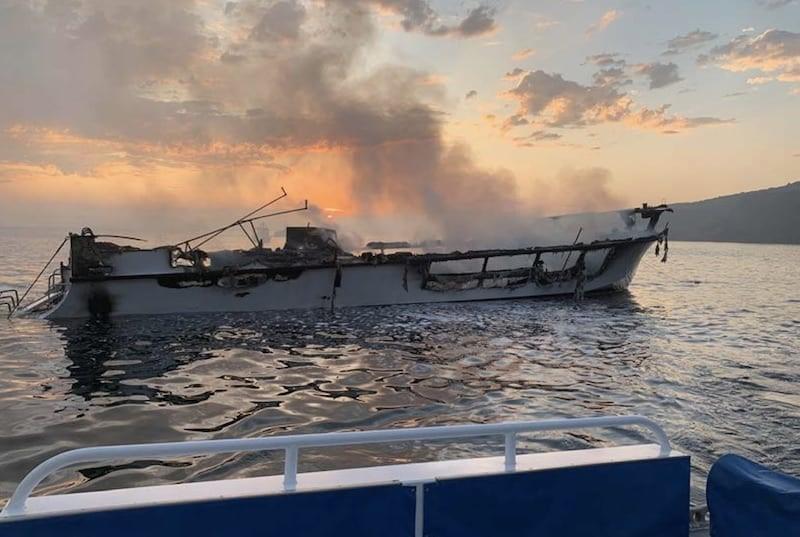Purpose
This safety alert aims to raise awareness of recommendations made by the United States National Transportation Safety Board (NTSB), following the investigation into the fire that resulted in 34 fatalities and subsequent loss of the passenger vessel Conception.
While this incident did not occur in Australia or on an Australian vessel, the findings of the NTSB investigation provide a useful reminder to our industry on the importance of having an effective safety management system (SMS) in place.
The incident
Conception was a 22.8 metre United States flagged passenger vessel that caught fire in the early hours of 2 September 2019 off Santa Cruz Island, California. Of the 39 people on board, all 33 passengers and one crew member perished in the incident.
Five crew members were asleep in the crew berthing area on the upper deck. One crew member and the 33 passengers were asleep in the bunkroom below the main deck. A crew member on the upper deck was awakened by a noise and realised that fire was rising from the salon compartment directly below. The four other crew members sleeping on the upper deck, including the Master, were immediately alerted to respond.
The crew members attempted to access the salon to assist those in the bunkroom, but access was blocked by fire and smoke.
In response to a distress message sent by the Master, the Coast Guard and other first responder vessels arrived on scene within 90 minutes. Despite firefighting and search and rescue efforts, the vessel burned to the waterline and sank just after daybreak with 34 souls still onboard.

Findings
The NTSB report drew a large number of findings, the following of which are considered worthy of note by those operating passenger vessels in Australia:
- The most likely ignition sources were the electrical distribution system of the vessel, unattended batteries being charged, improperly discarded smoking materials, or another undetermined ignition source.
- Evidence indicated that the overnight, unattended charging of a large number of batteries was normal practice in the salon compartment. This risk had not been considered.
- A primary contributory factor was failure by the Conception’s operator to provide effective oversight of its vessels’ operations, which jeopardised the safety of crew members and passengers. This included the absence of an overnight roving patrol and lack of smoke detectors in the salon which allowed the fire to grow undetected, precluded firefighting and evacuation efforts, and directly led to the high number of fatalities.
- Conception’s emergency escape arrangements were inadequate because both means of escape led to the same space, which was obstructed by a well-developed fire, and the escape hatch was located directly above the bunks.
The analysis section of the report noted that since the salon compartment was a critical element in the egress pathway from the passenger bunkroom, prudent fire safety planning should have minimised risky activities (unattended charging of batteries) and materials, such as the plastic chairs and polyethylene trash cans that could contribute to a fire, in this area. Each device and battery represented a separate potential source of ignition.
The master of the Conception was later convicted by a US attorney’s office of criminal negligence in connection with the deaths of the 34 people aboard the vessel.
Reminder
- Review the risk assessment for your operation regularly and ensure fire risks are adequately considered. Update your SMS as required.
- The SMS should include fire safety briefings to passengers at the start of the voyage and regular fire drills with the crew.
- Ensure that the SMS is effectively implemented and followed at all times.
- Ensure you have in place sufficient watch arrangements on your vessel, including the use of a roving patrol during sleep periods.
- Consider emergency escape options for your vessel, including a secondary means of escape into a different space than the primary exit.
- Ensure that smoke and fire detection systems on your vessel are compliant, allow for proper coverage and ensure they are regularly tested and properly maintained.
- Consider interconnected smoke and fire alarms to allow for early detection.
- Consider installing Carbon Monoxide monitors in below-deck areas containing passenger spaces.
- Consider engaging a marine electrician to verify whether there are limitations on your vessel’s electrical system restricting the simultaneous use of appliances such as air conditioning, battery chargers, water heaters, galley appliances and electronics.
- Consider engaging a marine electrician to conduct inspection and resistance testing of the vessel’s electrical cabling and connections as part of the ongoing maintenance plan for the vessel.
- Develop a procedure for charging electronic devices away from flammable items and in a controlled location / container.
- Lithium Ion battery installations should meet manufacturers' requirements and Australian/New Zealand Standard 3004 (Electrical installations – Marinas and pleasure craft at low voltage).
Further reading
- NTSB report—Fire Aboard Small Passenger Vessel Conception, Platts Harbor, Channel Islands National Park, Santa Cruz Island, 21.5 miles South-Southwest of Santa Barbara, California (ntsb.gov)
- AMSA Safety alert 05/2020—Fire prevention and protection
- WA Department of Mines, Industry Regulation and Safety—Lithium—Ion Battery Safety
- DCV Safety Alert 02/2023 – Risks Associated with the Carriage of Battery Electric Vehicles (amsa.gov.au)